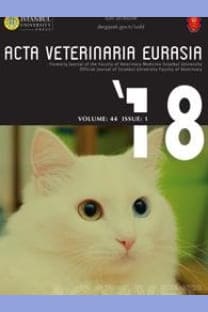A Survey Study on Self-Evaluations of Small Pet Practitioners about Exotic Pets in Istanbul in 2016
___
AEMV, 2000. Association of Exotic Mammal Veterinarians: http://aemv. org/ (Accessed on 21.11.2018).ARAV, 1990. Association of reptilian and amphibian veterinarians. https://arav.org/ (Accessed on 21.11.2018).
Chomel, B.B., Belotto, A., Meslin, F.X., 2007. Wildlife, exotic pets and emerging zoonoses. Emerging Infectious Diseases 13, 6-11. [CrossRef]
Donnelly, T.M., 2004. Share the knowledge. Laboratory Animals 33, 7-7. [CrossRef]
Ebani, V.V., Fratini, F., 2005. Bacterial Zoonoses Among Domestic Reptiles. Annali della Facoltà di Medicina Veterinaria di Torino 58, 85-91.
ECZM, 1993. European College of Zoological Medicine. https:// www.eczm.eu/ (Accessed on 21.11.2018).
Marano, N., Arguin, P.M., Pappaloanou, M., 2007. Impact of globalization and animal trade on infectious disease ecology. Emerging Infectious Disease 13, 1807-1809. [CrossRef]
Mayer, J., Martin, J., 2005. Barriers to exotic animal medicine. Veterinary Clinics: Exotic Animal Practice 8, 487-496. [CrossRef]
Merriam-Webster, 2003. Merriam-Webster’s Collegiate Dictionary, ed 11, Springfield, Mass.
Miller, R.E., Fowler M.E., 2014. Fowler’s Zoo and Wild Animal Medicine, Vol. 8. Elsevier Health Sciences, Missouri.
Mitchell M.A., Tully T.N., 2009. Manual of exotic pet practice. Saunders, Elsevier Health Sciences, Missouri, 1-3. [CrossRef]
Öner, A.C., Şahin, A., 2009. Egzotik Hayvanlarda Antibakteriyel Tedavi. Yüzüncü Yıl Üniversitesi Veteriner Fakültesi Dergisi 20, 81-86.
Özdamar, K., 2003. SPSS ile Biyoistatistik. Kaan Kitabevi, Türkiye.
RSPCA, 2003. Handle with care: a look at the exotic animal pet trade. www.rspca.org.uk/. (Accessed on 02.03.2016).
Schuppli, C.A., Fraser, D., 2000. A framework for assessing the suitability of different species as companion animals, Appendix C; Animal Welfare 9, 359-372.
Souza, M.J., 2011. One health: zoonoses in the exotic animal practice. Veterinary Clinics: Exotic Animal Practice 14, 421-426. [CrossRef]
Vander Veen, K.A., Schulte, M.S., 2005. Educating the Exotic Animal Technician. Veterinary Clinics: Exotic Animal Practice 8, 525-530. [CrossRef]
- ISSN: 2618-639X
- Yayın Aralığı: 3
- Başlangıç: 1975
- Yayıncı: İstanbul Üniversitesi-Cerrahpaşa
Theophilus Aghogho JARIKRE, Benjamin Obukowho EMIKPE
Diana Valeriyivna FESHCHENKO, Tetiana Ivanivna BAKHUR, Biricik Halil SELÇUK, Anatoliy Anatoliyovych ANTIPOV, Oksana Anatoliyivna ZGHOZINSKA, Oksana Anatoliyivna DUBOVA, Valentina Oleksandrivna YEVSTAFYEVA, Volodymyr Petrovich GONCHARENKO, Raisa Volodymyrivna SHAHANENKO, Volodymyr Sergiyovych SHAHANENKO, Vital
KADİR EMRE BUĞDAYCI, HIDIR GÜMÜŞ, MUSTAFA NUMAN OĞUZ, Fatma KARAKAŞ OĞUZ, İSKENDER GÜLLE
A Survey Study on Self-Evaluations of Small Pet Practitioners about Exotic Pets in Istanbul in 2016
